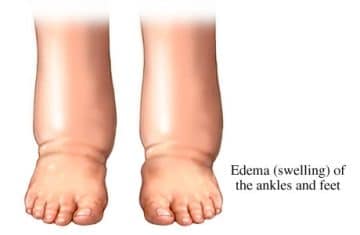Share this post
Summer is the season many people wait all year for. Sunshine, fun, outdoor activities, warm weather, watermelon. Doesn’t everything just feel better in the summer? While the love for this season is undeniable, there is something about it that many of us don’t love: the fact that summer also means swollen feet and ankles.
[ninja_tables id="73270"]
You must have seen or heard that when a person stands or sits in a hot environment for a long time, the person’s hands or feet get swollen. You have probably experienced this yourself.
If you are here, reading this article, then you are probably wondering why this happens. Why does the beloved summer season mean the swelling of your feet and ankles?
Well, this is nothing more than ‘Heat Edema’. Read on to find out what heat edema is all about, why leg swelling often worsens in the summer heat, and what you can do about it.
Heat Edema – What is it?

Edema is “swelling caused by excess fluid trapped in your body’s tissues.” Therefore, Heat edema specifically is this swelling that occurs when temperatures are high. Heat edema is a cutaneous condition characterized by dependent edema from vasodilatory pooling.
Heat causes the blood vessels to expand (dilate), so body fluid moves into the hands or legs by gravity.
There are some people that are more at risk of heat edema than others. This includes people who are not used to being in hot climates. Their bodies have not had time to acclimate to the high temperatures and may suffer as a result.
Additionally, people who are overweight also are at a higher risk of heat edema due to their tendency to hold more water, as well as people who are older.
However, heat edema can also occur in young, healthy people so be attentive to signs you may have edema. And there you have it — the reason why your feet and ankles swell in the heat.
Causes of Heat Edema
The body uses the mechanism of peripheral vasodilatation in hot temperatures to maintain a normal body temperature. Vasodilatation is a phenomenon in which the blood vessels widen or open up to increase the blood flow to the lower extremities.
Also, the skin loses a large amount of water through sweating when the outside temperatures are high. When the blood flow to the body organs increases, the tiny capillaries present in the body leak out fluids into the space present outside the cells; normally, this fluid is cleared up by the lymph nodes.
However, the problem arises when the fluid is in excess, and the lymph nodes are unable to clear it. As a result, the fluid starts accumulating in the body parts, including the hands, legs, arms, and ankles, resulting in a condition known as heat edema. The following factors increase the risks of heat edema:
- Prolonged standing: If the patient sits or stands for a long period in hot weather, h/she is more likely to develop heat edema. It is because the veins of the legs become weak, and the water accumulates in the feet due to gravity resulting in edema.
- Heat: Heat causes the blood vessels to expand (dilate), so body fluid moves into the hands or legs by gravity.
- Pregnancy: Pregnant females should stay indoors during summer because they are more likely to suffer from heat edema. During pregnancy, the body retains more fluids compared to normal conditions, which increases the risk of edema.
- Imbalanced osmoregulation: The balance of salt in the body is also a risk factor for heat edema. If salt loss is less than normal, the increased salt level draws fluid into the hands and legs.
- Age: Older adults have an increased risk of heat edema, especially if they have other medical conditions that affect their circulation.
- Change of climates (lack of acclimatization): People visiting hot climates from colder climates may also have an increased risk of heat edema.
- Heart Failure: People suffering from heart diseases or congestive heart failure are more likely to develop heat edema. It is because the heart is unable to pump blood properly. As a result, the blood flows back to the legs, feet, and ankles resulting in swelling or edema.
- Diabetes: Diabetes or high blood sugar levels increase the risk of heat edema. It is because the excess glucose levels damage the small blood vessels resulting in impaired blood flow. When the blood does not flow properly, the fluid accumulates in the organs of the body.
- Kidney Diseases: The kidneys are the most crucial organs of the urogenital tract. They contain tiny units known as nephrons that filter the blood and form urine. The kidneys also work to reabsorb the essential minerals and electrolytes from the blood. It is the duty of the kidneys to remove excess fluids and maintain the fluid levels of the body. However, when the kidneys fail to carry out their activities, the fluids accumulate in the body resulting in the swelling of the body parts.
- Medications: The following medications increase the risk of edema;
o Antihypertensive drugs
o Nonsteroidal anti-inflammatory drugs (NSAIDs)
o Steroids
o Estrogen.
o Antidiabetic drugs
How to Know if You Have Heat Edema? – Signs and Symptoms of Heat Edema
The most obvious sign of heat edema is leg and feet swelling, but other symptoms include:
- Swelling or puffiness of the tissue directly under your skin, especially in your legs or arms
- Stretch or shiny skin
- Skin that retains a dimple (pits), after being pressed for several seconds
- Increased abdominal size
If you have edema that occurs at other times (not just heat-related) and is associated with any of the symptoms listed below, this is often a sign that the problems could be related to your veins, so you should schedule an appointment with one of our physicians to be sure you’re not experiencing signs of vein disease.
Contact the doctor immediately if you have edema that is associated with any of the following:
- Leg aching
- Pain
- Redness
- Heaviness
- Fatigue
- Itching
- Burning
- Restlessness
- Cramping or Charlie horses
Is Heat Edema Common? – Which Gender, Age, or Set of People is Heat Edema More Common?
- Older adults: Old people have an increased risk of heat edema, especially if they have other medical conditions that affect their circulation.
- Pregnant women: Pregnant females are at a higher risk of developing edema because during pregnancy, the extra fluid in the body and the pressure from the growing uterus can cause swelling (or "edema") in the ankles and feet. The swelling tends to get worse as a woman's due date nears, particularly near the end of the day and during hotter weather.
- Overweight or obese people: People who are overweight also are at a higher risk of heat edema due to their tendency to hold more water.
- People visiting hot climates from colder climates: People visiting hot climates from colder climates may also have an increased risk of heat edema because their bodies have not had time to acclimate to the high temperatures and may suffer as a result.
However, heat edema can also occur in young, healthy people, so be attentive to signs you may have edema.
Effects of Heat Edema - Can Any Complications Arise from Heat Edema?
Yeah, heat edema if left untreated or not taken care of as soon as possible, and you continue to be doing what induces it or continue staying in that area that is causing the heat edema like in a hot environment or staying in the sun for too long, then ofcourse, heat edema can prove harmful to the body system.
Deep vein thrombosis is a condition that makes heat edema a dangerous one. It is a disorder in which the blood clots break and travel freely in the body. Deep vein thrombosis is a life-threatening condition, and head edema increases its risk. The other complications or dangers of heat edema include the following:
- Pain due to swelling or stretched skin
- Swelling or puffiness of the tissue directly under your skin, especially in your legs or arms.
- Stretch or shiny skin.
- Skin that retains a dimple (pits), after being pressed for several seconds.
- Stiffness of the joints.
- Walking difficulties.
- Shortness of breath (pulmonary edema).
- Irritation and inflammation of the skin.
- Skin rashes or sores.
- Chest pain.
- Behavioral changes (cerebral edema).
How to Treat Heat Edema - What Tests Are Done to Diagnose Heat Edema?
The diagnosis of heat edema is based on medical history, physical examination, laboratory tests, and imaging tests. The diagnostic methods have been described below:
- Medical History: The medical history provides information about the general health of the patient. It provides an idea about the symptoms of the condition, the drug history, and the other conditions the patient is suffering from. For example, patients living in hot environments and suffering from renal or cardiac diseases are more likely to develop heat edema. Similarly, heat edema is more likely to develop as a side effect in patients taking antihypertensive drugs for a prolonged period.
- Physical Examination: Swelling of the hands, arms, legs, and ankles is visible on physical examination. The doctor applies light pressure on the swelling with his finger for 10 to 15 seconds. If a dent or a depression is created when the pressure is removed, it is known as pitting edema.
- Laboratory Tests: Laboratory tests are usually recommended to check urine output. The following laboratory tests must be done to diagnose heat edema:
-Urinalysis - In this test, the patient collects the urine in a container. The urine sample is then sent to the laboratory for examination under a microscope. The presence of blood and bacteria in the urine is indicative of kidney disease.
-Blood Tests - The doctor recommends the patient undergo a blood test to check the general health and the presence of infection.
- Imaging Tests: Imaging tests are usually recommended to check whether the fluids have accumulated in the other organs of the body. The following imaging tests are usually recommended:
-Computerized Tomography (CT) Scans - This procedure provides three-dimensional (3D) images of the internal organs of the body. The patient is laid on a table that slides into a tunnel-like device where the X-rays are taken. These images help to check the accumulation of fluids in the other organs like the lungs, heart, liver, and abdomen.
-Chest X-Ray - The X-ray machine is positioned near the chest of the patient to obtain the images. A chest X-ray is done when the patient experiences respiratory difficulties. It helps to check the accumulation of fluids in the lungs.
-Ultrasound - It is an imaging test in which sound waves are sent to the body to obtain images of the internal organs. The patient is laid on a table, and the doctor moves a device known as a transducer over the abdomen. The images are obtained on the computer screen. This test is especially done in pregnant females to check the fluid accumulation due to heat edema.
Sometimes treating heat edema can be as simple as elevating your feet and lowering your salt intake. However, if that is not proving to be enough, your heat edema may be a sign of greater venous insufficiency.
This can be alleviated by compression stockings but can only be treated by a type of procedure called endovenous ablation. These forms of treatment are used to collapse or close damaged veins so that blood can be directed to healthy veins.
Before any therapy can begin, the root issue of the edema should always be identified. Diagnostic testing may include the following:
- Physical examination
- Medical history
- Specific inquiry concerning fluid retention, such as when it began, any things that increase the edema, and whether it is continuous or intermittent blood tests
- Urine examinations
- Testing for liver function
- Kidney function examinations
- Heart function testing like ECG.
Ankle, foot, and leg swelling ought to be gone on its own, but there are various things you may do to assist. Treatment options may include:
- A low-salt diet
- Diuretics (water pills)
- Treatment for the underlying medical condition: for example, in the case of hypothyroidism, hormone replacement (thyroxine) therapy can be used.
- Lifestyle adjustments
- Treatment of the underlying medical problem; for example, in the case of liver illness, then abstaining from alcohol is the treatment recommended.
- If medications are the cause, dose modifications should be made
- If malnutrition is the cause, dietary adjustments should be made.
- Continued medical monitoring and assistance such as support stockings should be used.
Drugs that assist your body to eliminate extra fluid in the form of urination may be used to treat more severe edema (diuretics). Furosemide is among the most often used diuretics (Lasix). However, based on your unique medical history, your doctor will assess whether these sorts of drugs are a great choice for you.
In most cases, long-term therapy focuses on addressing the root cause of the edema. If edema develops as a result of drug use, your physician may change your dosage or look for a different medicine that does not cause edema.
How to Prevent Heat Edema - How to Manage Heat Edema?

Heat edema, or the swelling that occurs due to prolonged exposure to high temperatures, usually subsides after some time. However, the following methods help to treat heat edema:
- Elevation - The patient must elevate his legs several times during the day to improve the flow of blood to the body organs. Keep 2 to 3 pillows below the legs while sleeping as it improves blood circulation, and prevents the accumulation of fluids.
- Compression Stockings - Compression stockings are of great help in reducing swelling, and they are easily available in the medical store. These stockings put pressure on the legs and do not allow the fluids to accumulate in a place.
- Take a Break - Avoid standing for prolonged periods in hot weather as it increases the risk of edema. Take a break and sit for 10 to 15 minutes in a cool place for proper fluid movement.
- Consume Less Salt - Salts contain a large amount of sodium which increases the risk of edema. Salty food items like potato chips, salted peanuts, and pizza must be avoided to prevent heat edema.
- Stay Indoors - If the patient is unable to tolerate heat, he must avoid going out and must stay at home. It is because the risk of heat edema increases due to a lack of acclimatization.
- Drink Water - Drink a sufficient quantity of water daily to prevent dehydration, especially in hot weather. Water helps to flush out the waste products from the body.
- Maintain a Healthy Weight - People who are obese tend to hold a large quantity of fluids in their bodies. A healthy diet and exercise are the two keys to maintaining a healthy weight.
- Keep Moving - Do not sit in the same position for a long time. Go for a walk regularly as it helps to improve blood circulation.
- Medications - Medications, mainly diuretics help to remove the excess fluids from the body. Consult the doctor before taking any such medications.
- Quit Smoking - Live a healthy life and quit smoking because it increases the risk of liver and lung diseases. Bronchitis and emphysema are one of the causes of edema.
The best way to avoid swelling due to heat is to stay out of hot temperatures. If you live in a climate where that is not an option, then try to stick to cool areas as much as possible.
In addition, staying hydrated will help to keep overheating and pooling issues at bay. Be sure to also move regularly and never spend too much time sitting or standing in one place as this is known to cause uncomfortable leg swelling as well.
Fluid Retention Self-care Options

Mild fluid accumulation can be alleviated by doing the following:
- Reduce your salt intake by not adding too much salt during cooking and refrain from salting your food at the table. Foods like salted peanuts and potato chips should be avoided. Be aware of processed foods that contain 'hidden' salt, such as made meats.
- Vitamin B6 (pyridoxine) may be beneficial in situations of minor fluid retention. Red meat and brown rice are excellent sources of vitamin B6, so make sure to include them in your diet.
- Vitamin B, calcium, and vitamin D aid in the excretion of excess fluids. Consume fresh fruit, vegetables, and low-fat dairy products on a regular basis to gain these vitamins and nutrients.
- Supplements such as manganese, magnesium, evening primrose oil, calcium, and the chaste tree may be beneficial in cases of fluid retention induced by the menstrual cycle. So, make sure to utilize them.
- Dandelion leaf, maize silk, and horsetail are examples of herbal diuretics, so you can include them in your diet.
- Discuss the use of vitamins and supplements with your physician or other healthcare practitioners, especially if you are taking medication.
- Consume lots of water. Although it may appear counterintuitive, a well-hydrated body system is less prone to retain fluid.
- Reduce your intake of dehydrating beverages such as tea, coffee, and alcohol.
- Cranberry juice has a little diuretic effect, so you can include it in your diet.
- When feasible, lie down and lift your legs further than your head with cushions.
- Regular exercise, such as walking, can help increase blood flow.
- Wear shoes that are broad and comfy, with a low or flat heel and a soft sole.
- To avoid infections, wash, dry, and moisturize your feet.
- Do not sit or stand for extended periods of time. Do not wear clothing, socks, or footwears that are excessively tight.
If your ankle, foot, or leg is swollen and has not alleviated after a few days of home treatment, see a doctor.
Healthsoothe’s Advice about Heat Edema
Heat edema is a condition in which some parts of the body, like the hands, legs, ankles, and arms, swell due to excessive heat. This condition is mainly seen in summer because the outdoor temperatures are usually high during that time. Pregnant females and elderly people are more likely to be affected by heat edema.
Also, the ones who are not used to the high temperatures, suffering from kidney diseases, diabetes, and cardiac diseases are at a higher risk of developing heat edema. Excessive heat causes the widening of the blood vessels.
As a result, the fluid leaks out and accumulates beneath the skin. If the condition is left untreated for long, the fluids accumulate in other organs of the body like the lungs, liver, heart, and brain.
Maintaining a healthy weight, keeping the legs elevated during sleep, drinking plenty of water, staying indoors in summer, and living a healthy life are some of the ways to prevent heat edema. Consult the doctor to know more about heat edema and the ways and means to prevent it.
If you have edema that occurs at other times (not just heat-related), this is often a sign that the problems could be related to your veins, so you should schedule an appointment with one of our physicians to be sure you’re not experiencing signs of vein disease.
All right, guys, that is it for now for heat edema. I hope Healthsoothe answered any questions you had concerning heat edema.
Feel free to contact us at contact@healthsoothe.com if you have further questions to ask or if there’s anything you want to contribute or correct to this article.
You can always check our FAQs section below to know more about heat edema. And always remember that Healthsoothe is one of the best health sites out there that genuinely cares for you. So, anytime, you need trustworthy answers to any of your health-related questions, come straight to us, and we will solve your problem(s) for you.
Frequently Asked Questions about Heat Edema
Does Heat Edema Go Away?
Heat edema, or the swelling that occurs due to prolonged exposure to high temperatures, usually subsides after some time. If your ankle, foot, or leg is swollen and has not alleviated after a few days of home treatment, see a doctor.
How Can a Person Get Rid of Heat Edema?
Does Excessive Heat Worsen Edema?
Edema or swelling occurs when excessive fluids get trapped in the body tissues. For example, excessive heat causes the widening of the blood vessels. As a result, the fluid leaks out and gets stored in the body tissues, resulting in edema. Edema is a common problem during the summer season.
Can Excessive Heat Be the Reason for Edema?
There are several causes of edema, including diabetes, pregnancy, heart failure, and kidney diseases. Excessive heat is one of the causes of heat edema because the fluid tends to leak out of the blood vessels at high temperatures. When this fluid remains in the body for long, it accumulates in the tissues and causes swelling or edema.
Is There Any Medicine Available for Edema?
Edema is a medical term used to describe swelling of the body parts due to the accumulation of fluids. Diuretics, also known as water pills, are the commonly used drugs to treat edema. They stimulate the kidneys to form urine and expel the fluids from the body. The most commonly used diuretic to treat edema is Furosemide.
Should I Drink More Water to Get Rid of Edema?
How Should One Get Rid of Fluid in the Legs and Feet?
Is Heat Edema a Sign of Danger?
As the name suggests, the edema or swelling that occurs due to heat or high temperatures is heat edema. Heat edema does not cause any major harm in most cases. However, it is dangerous under certain circumstances. For example, certain medical conditions like diabetes, cirrhosis, and heart failure increase the risk of edema and indicate something serious or dangerous.
Can Heat Edema Be Dangerous at Any Point?
Does the Heat Make a Face Puffy?
Is Facial Edema Dangerous?
How to Get Rid of Facial Edema?
Do Fingers Swell in Heat?
Mild swelling of the fingers occurs in excessive heat. Swelling of the fingers is more commonly seen in females because heat increases the blood supply of the skin. As a result, more fluids get stored in the tissues of the hand, resulting in swelling in the fingers and hands.
How Do You Get Rid of the Swelling in Your Hands?
What Does Heat Edema Look Like?
The most obvious sign of heat edema is swelling of the hands, legs, and feet, but, according to the Mayo Clinic, other symptoms may include: Swelling or puffiness of the tissue directly under your skin, especially in your legs or arms. Stretch or shiny skin. Skin that retains a dimple (pits), after being pressed for several seconds.

I Am odudu abasi a top-notch and experienced freelance writer, virtual assistant, graphics designer and a computer techie who is adept in content writing, copywriting, article writing, academic writing, journal writing, blog posts, seminar presentations, SEO contents, proofreading, plagiarism/AI checking, editing webpage contents/write-ups and WordPress management.
My work mantra is: “I can, and I will”

